
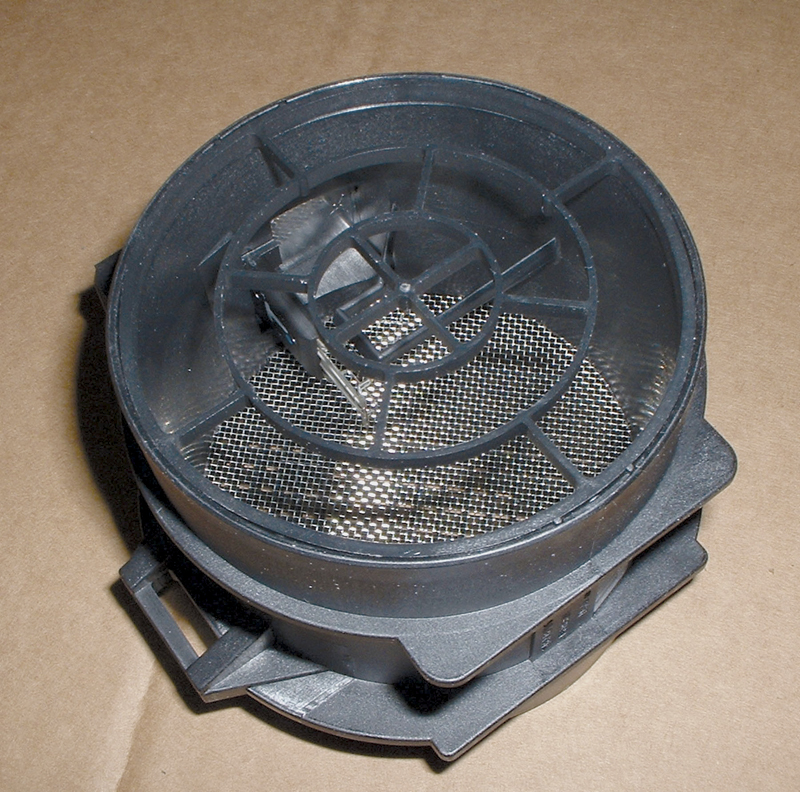
Nothing else yet devised is as good at telling the engine management computer the actual mass of the air it’s ingesting as the air mass meter, otherwise known as the MAF.
Did you ever think that a carburetor is actually a crude air mass meter? Or, are you of the younger generation that never worked on a carburated car? We often get a wake up call on our own age when we talk about such things, but being in California, we still get a small percentage of vehicles with carburetors, though obviously not BMWs, which have had fuel injection, whether K-Jetronic, L-Jetronic, Motronic, etc., for decades. In any case, the job of the carburetor with its throat and venturi was to approximate the volume of air passing into the engine and add the appropriate amount of fuel. With or without a feedback system, anything that upset the ability of the carb to control the amount of intake air, or to meter the proper amount of fuel atomized into that air would skew the air/fuel ratio. Vacuum leaks, PCV problems, fuel supply restrictions, heavy floats, and so forth would all have their negative effect on engine performance, idle quality, acceleration characteristics, and exhaust emissions.
Just as many techs of the past working without proper diagnostic strategies used to condemn carburetors when the problem was really in another area, so today an improper approach to diagnosis will result in condemning air mass meters that are not necessarily defective.
Transfer of learning
As they say, the more things change, the more they stay the same. That is a fortunate fact for us in the vehicle service business. If we could not transfer forward our knowledge (educators call it “transfer of learning”), we’d be hung out to dry as far as keeping up with technology. We need that basic understanding of operating principles in order to build skills that apply to today’s technology. This is not to suggest it isn’t tough enough as it is, but the very fact that you as a technician are reading this magazine and this article suggests that you have an interest in keeping up. So let’s see what we can do to further our understanding of the hot film air mass meter used in BMWs, based on what we already know about engine dynamics, fuel delivery, and the ability of the DME to control air/fuel ratio. Though BMW used vane airflow meters, then hot wire sensors before 1996, for the purposes of this article we will stick to the hot film air mass meter.
Any of the problems that we mentioned above concerning a carburetor will also affect an air mass meter system. All of the air being fed to the engine, minus air coming through the PCV and canister purge systems, needs to travel through the air mass meter (or, to use the standardized SAE term, Mass Air Flow sensor, or MAF).
Principles
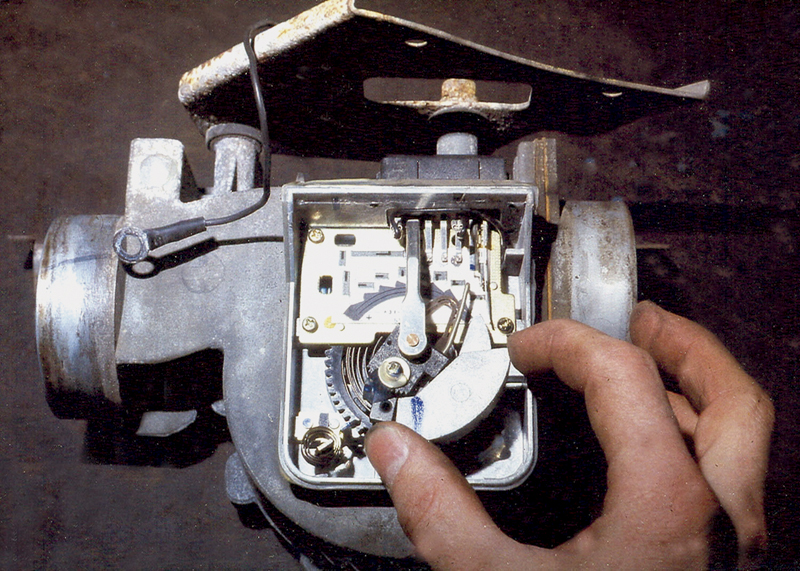
The old L-Jetronic vane airflow meter, or VAF, was ingenious. The swinging spring-loaded flap rotated a variable resistor (or, potentiometer) according to the cfm of air that was entering the engine. The trouble was, it couldn’t account for the actual mass of the air, just its cubic volume.
The first Robert Bosch electronic fuel injection system was D Jetronic. Introduced way back in 1968, it used a vacuum sensor (the “D” is for “Druck,” which means “pressure” in German) to inform the electronics about the intake situation, but in ’74 the air flow meter, or VAF (Vane Air Flow) showed up on L Jetronic (the L stands for “Luftmengenmessung” auf Deutsch, meaning “air flow management”), also known as AFC (Air Flow Controlled) fuel injection. At the time, we thought the concept was ingenious: A vane rotated against spring pressure according to how much of the atmosphere the engine was ingesting, and this movement turned the shaft of a variable resistor, thus changing the reference signal before it returns to the computer. Simple, and much more accurate than anything else ever devised.
The jump to direct mass measurement occurred in 1984 when LH-Jetronic with its hot wire sensor was introduced (to continue our foreign language lesson, the “H” stands for “Heisz,” German for “hot”). Then came the hot film MAF (Mass Air Flow) sensor.
A retail analogy will help illustrate this evolution. Suppose you were in the business of selling air. You could calculate the amount delivered by using a complicated formula that takes pressure, temperature, and the diameter of the valve into account, but that would be slow, unwieldy, and probably not very accurate (think of the speed-density systems you may have seen on Asian cars).
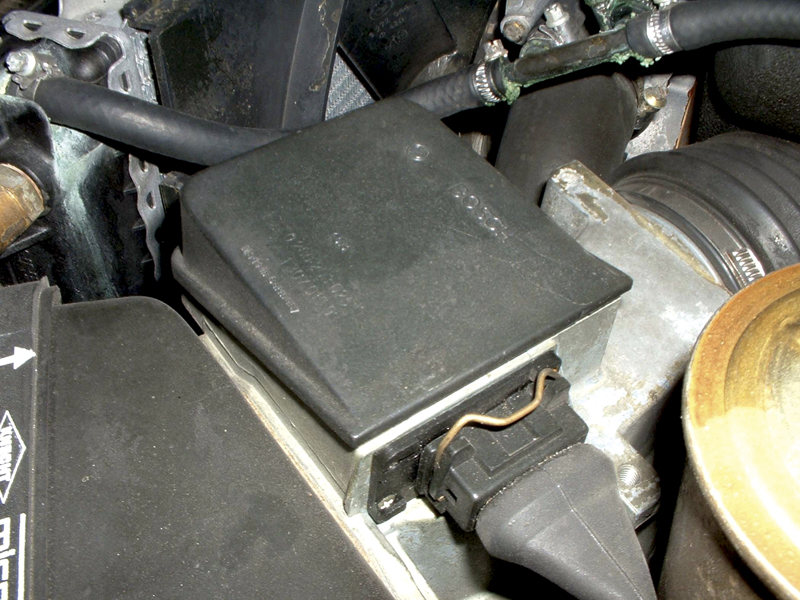
This VAF variable resistor sensor is installed on an old M inline six. Performance was great, but would’ve been even better with a MAF/AMM.
You’d improve the efficiency of your operation considerably if you had a way of directly measuring the volume flowing into your customer’s air canisters in cubic feet per minute. That would sure speed things up, but it wouldn’t be perfect, either. On cold days, they’d be getting a big bargain because any gas is denser when it’s cold than when it’s hot — in essence, you’d be giving them a baker’s dozen and then some. Sales would go way up (and profits way down) in winter as soon as your patrons realized that fact of physical reality. And they’d always try to buy at sea level in dry weather because altitude and humidity affect density, too.
To keep from losing your shirt, you’d still have to use a formula that varied the price per cubic foot according to temperature, altitude, and moisture content. Wouldn’t it be a lot easier, faster, and more precise if you had a meter that read out in the actual weight instead of just the volume? Sure it would.
Back to engines. A direct reading by means of a VAF sensor aids swiftness and accuracy, which are both critical if optimum performance, high fuel efficiency, and low emissions are to be achieved. Since air/fuel ratios are by weight (stoichiometric is 14.7 lbs. of air to one lb. of gasoline — in gallons it would be about 2,000 to one), however, measuring mass makes even more sense, so for many years BMWs have had sensors that do just that.
An air mass meter has some other advantages besides its ability to account for density: no moving parts, restrictions, or compensating sensors. A typical late-model BMW MAF has a film element that’s kept heated to a specified temperature above ambient (180 deg. C.) and is exposed to intake air. Through a Wheatstone bridge circuit and dedicated electronics, the amount of current required to maintain that temperature becomes the signal to the computer. High air flow obviously has a greater cooling effect than low, but so does the denser air of cold days and low altitudes, so the DME gets the true data on mass it needs to provide the longer injector pulse width that extra oxygen needs to fire dependably. The units used in BMWs produce an analog voltage output.
Bosch or Siemens?
The hot film air mass meter has been around for many years now, one version manufactured by Robert Bosch and the other by Siemens (Hint: Bosch systems are labeled “M,” while Siemens systems are identified by “MS” — for example, the M5.2 Bosch, or the MS41.1 Siemens). Since they have no moving parts and are less apt to foul than the hot wire type, both are very reliable meters. They operate on a principle of thermodynamics: If we move air over a heated surface, the heat from the surface will transfer to the air and there will be a cooling effect. The meter will attempt to hold the surface at a specific temperature (the 180 deg. C mentioned above) by supplying more current to the heating element as airflow and therefore heat transfer increases.
This effort is translated into an analog signal. That is, its output voltage changes based on airflow from around .6 volts at idle to over four volts under heavy throttle conditions. How this is reported to the scan tool varies by model and year, but most commonly the tech will see the parameter reported in kilograms per hour (kg/h) rather than a voltage value or grams per second (gm/s). Hot film sensors are generally less subject to contamination problems than the previously-used hot-wire sensor. Low-quality air filters, filters that use oil as a filtering aid, and dirty air in general are very hard on hot wire sensors. They can affect the hot film sensor as well, but are less likely to do so.
Codes and scan tools
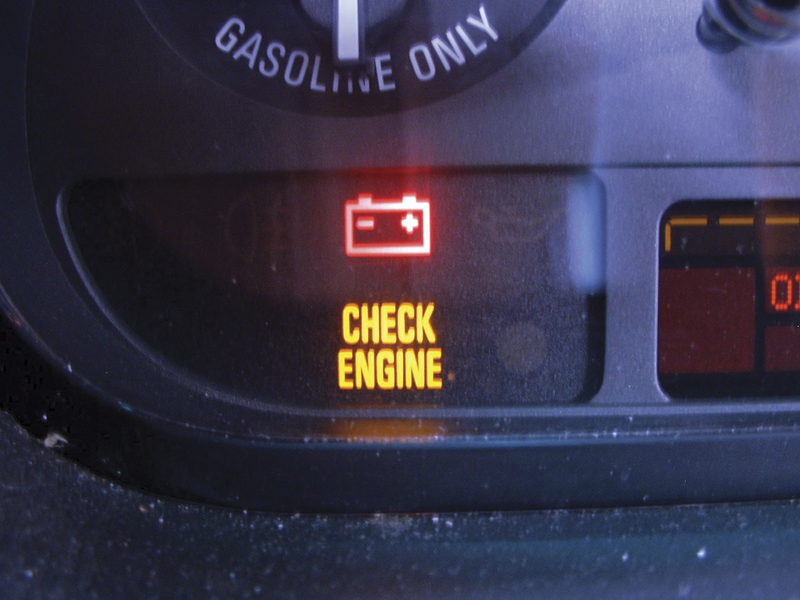
While a lack of power or a rough idle due to an AMM problem might not bring the customer in, an illuminated MIL probably will. Ditto for a failed emissions test.
Air mass meters are notoriously poor at diagnosing themselves directly, particularly when the failure is due to a loss of accuracy in reading airflow. Many techs have trouble as a result when they find codes that are based on a problem with multiplicative or adaptive fuel trim, specifically P codes 0170 and 0173, or FC codes 202 and 203, 227 and 228. In talking to techs who own the BMW factory-specific GT-1 tool with the DIS software, we find they rarely discuss failures in terms of codes since the scan tool software will lead them down a diagnostic path based on the scanner’s interpretation of the FC code.
Most independents will be working with an aftermarket scan tool instead of the GT-1, so you’ll probably be proceeding on the basis of trouble code descriptions of what system may be causing the code. This means engaging your understanding of electronic engine management systems in general and your skills in using OBD II in order to perform effective diagnoses.
Customer communications
When a vehicle comes into the shop with a potential air mass meter problem, chances are it is due to one or more of four possible customer complaints. Number one would probably be lack of power; number two would be rough idle; number three would be an illuminated MIL (Malfunction Indicator Lamp); and number four would be a failed emissions inspection.
We’ve compiled quite a list of our own of probable symptoms of AMM trouble. Bosch tells you to expect starting problems both hot and cold, hesitation, stalling (especially under load), rough idle, and low power output. Also, the engine may fire up, then die.
Contamination of the sensing element, which slows response, will result in stumble, which brings us to the most prominent logical effect of a bad or non-existent AAM signal: transient throttle glitches, including stalling, sagging, and missing. If it’s far enough out of range to cause the DME to shift to limited operating strategy, overall performance and driveability will be lousy.
But don’t let these symptoms cause you to jump to an unfortunate conclusion and automatically replace that expensive sensor. Plenty of other malfunctioning components can result in the same kinds of annoying and inefficient engine behavior. So, check the basics first. That means ignition, compression, fuel pressure and volume, etc. Then there are all the other sensors and the wiring and connections that are part of every electronic engine management system. In short, don’t blame the AAM right off because most of them have proved to be pretty dependable.
OBD II continually examines the MAF under the comprehensive component monitor. It looks for an out-of-range signal, and compares output to values calculated from input on rpm, manifold absolute pressure, throttle position, and intake air temperature, then sets a generic DTC if there’s a discrepancy.
But codes can get you into trouble. All they should really be used for is aiming your diagnostic efforts in a general direction, not as the final word on what’s wrong. You’ll need to do some more troubleshooting and rely on your experience before you can be sure.
There’s a good quick check: With the key off, unplug the MAF’s harness connector, then start ‘er up. If the engine runs appreciably better now, it’s time for a new sensor.
In our shop, regardless of the customer complaint, we require that the car must be road tested unless it is unsafe to drive. We don’t know how it is in your area, but we can tell you that our customers are notoriously poor communicators. What they say they don’t like may vary pretty far from your experience, so you’d better start out with a comprehensive road test, preferably with the customer aboard. If the complaint is a lack of power, and you are constrained by speed limits in your area, shift into the lowest possible gear and see how well the engine will wind up in rpm. Badly shifted air mass meters will often limit engine rpm to well below the redline, though the feeling cannot always be distinguished on a road test from a blocked exhaust or low fuel pressure.
Visual and tactile
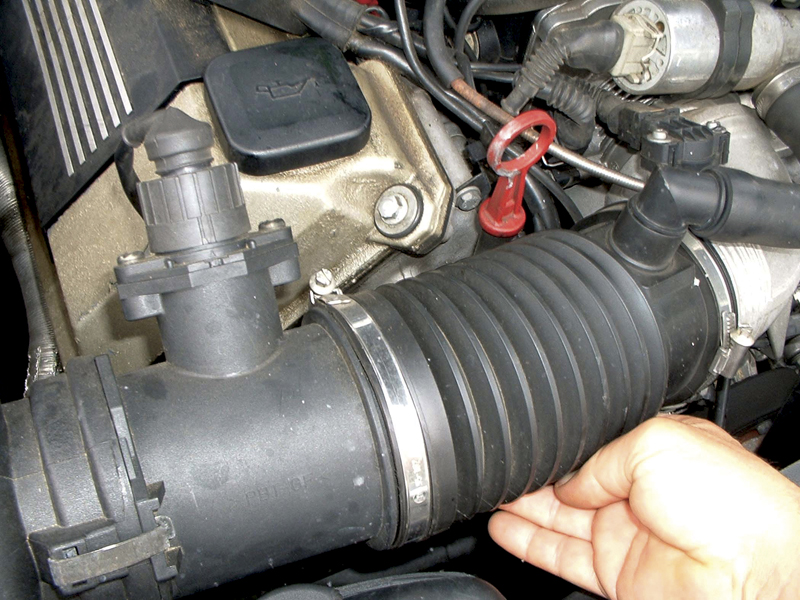
We’ve said this before, but it bears repeating: Whether from heat, rough handling, or even gnawing mice, the duct between the AMM and the throttle body seems to be vulnerable to perforation, thus admitting “false air” and causing the engine management computer to supply too short a pulse width.
The technician’s diagnostic path may vary based on the actual complaint after the road test, but an underhood inspection is always a good place to go next. Remember that unmetered air will generate a lean condition, since the AMM will underestimate the airflow and, as a consequence, the DME will produce too short an injector pulse width. Deteriorated vacuum hoses seems to be fairly common. These would include the hose going to the fuel pressure regulator and the hoses that route air to and from the idle air controller. These leaks are sometimes hard to find even with a smoke machine as the engine needs to be pulling a vacuum to get the leaks to open, while the smoke machine applies positive pressure and the leak will not always show up. From your starting point of the visual inspection, begin by squeezing the suspect rubber hoses and looking for the characteristic mushiness that may indicate a failure in vacuum tightness.
Of course, this goes doubly for the big duct between the AMM and the throttle body. For some reason, this seems to be vulnerable to the development of splits and holes.
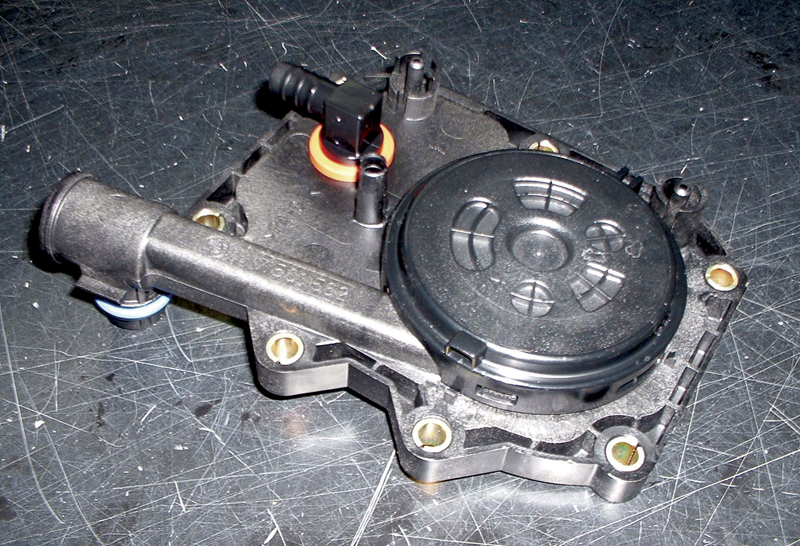
The PCV comes in downstream of the AMM, too, and BMW’s unusual crankcase ventilation unit, shown here, can develop a leaky diaphragm, which not only upsets the air/fuel mix calculation, but can also cause oil burning.
If your underhood visual inspection comes up dry, it’s time to break out your scan tool — we hope you have something that can do a better job than a standard generic OBD II code reader. Whether or not the MIL is on, check for codes. BMW is pretty good about setting codes for problems in airflow, though once again, they are systems codes, not component codes. Pay close attention to your multiplicative and adaptive fuel trim numbers. These numbers represent the amount of correction the DME has had to apply to its base injector pulse width, based on the value it calculated given the incoming parameter from the air mass meter. Multiplicative values are listed in percentage numbers, either plus or minus.
Fuel trim
Early (’96-’99) Siemens systems would set fuel trim codes when the multiplicative value exceeded 8% in either direction, rich correction or lean correction. Bosch systems could run the values as high as 25% before setting a code for rich or lean limit. Multiplicative numbers are the rough equivalent of what is called in SAE standardized terminology LFT (Long Term Fuel Trim). Some techs report that multiplicative fuel trim is based on memory cells that are not adapted at idle because they are biased according the engine load, but we were not able to confirm this. So, use your own powers of observation to check it for yourself. Create a vacuum leak at idle and observe whether multiplicative numbers move, or only additive numbers. Additive fuel trim is the equivalent of the SAE term SFT (Short Term Fuel Trim). This number is given in tenths of a millisecond, either plus or minus, and relates directly to the actual injector pulse width as it would be measured with a lab scope.
Positive numbers on both additive and multiplicative at idle are usually a good indication of an air leak. One spot of common trouble is the positive crankcase ventilation valve found at the rear of the intake manifold on BMW V8s and the bottom of the intake on sixes. The diaphragm will fail and apply excessive vacuum to the crankcase. BMW procedures (Bulletin #11 05 98) call for the use of an inches-of-water manometer to check crankcase vacuum. The spec is three inches to six inches of water, which is very little vacuum. The complaints listed in the service bulletin include rough running, a whistling noise, and MIL illuminated. The codes set may include O2 sensor codes 12 and 13 in OBD I, but the system should not set those codes from 1996 onwards.
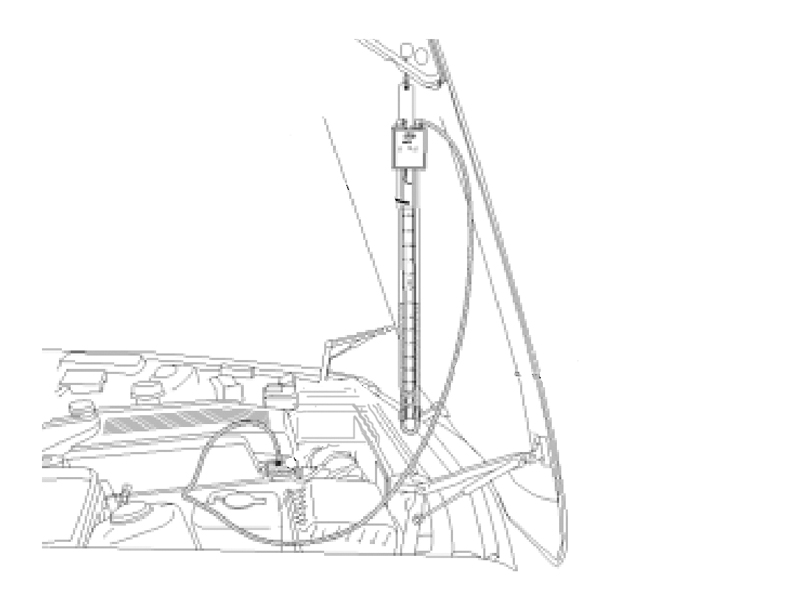
This inexpensive slack-tube manometer is sensitive enough to measure the low vacuum the PCV system is supposed to be operating under.
Intake manifold and throttle body gaskets are other possible vacuum leak locations. We often find these by feel, but smoke testing is becoming popular. Techs who don’t have a smoke machine can use a wand-type propane nozzle. Feed small amounts of propane to the suspected area while watching O2 and additive trim numbers for a reaction to an induced rich condition. If there is a leak, the O2 voltage should swing high while the additive trim starts subtracting pulse width. Another vacuum leak we occasionally encounter is inside the brake booster.
Positive and negative
Multiplicative numbers that are positive (greater than 10%) with adaptive numbers that are negative at idle are often a good tip-off that the air mass meter has drifted out of calibration. One diagnostic strategy is to clear the adaptive values (this requires a scan tool capable of this function; disconnecting the battery will not work on most OBD II BMWs). After clearing, drive the vehicle and see how it performs. Without the multiplicative fuel, the car will run terribly if the AAM is bad, often refusing to rev over 4,000 rpm, until the computer can re-adapt by adding back in the additional pulse width.
Adaptive numbers that are negative indicate an excess of fuel. This seems to be considerably less common than positive numbers, but when it occurs the place to look would be toward other factors that would cause a rich condition. Among these would be excess fuel pressure caused by a faulty regulator, or, on a return-type system, a pinched fuel return hose (we once removed a pair of Vice Grips from the return hose of a vehicle, apparently the result of someone’s effort to “increase horsepower”)! Other likely causes would be gas contaminated engine oil, dripping fuel injectors, or injectors that are stuck open.
In conclusion, diagnosing BMW air mass meter sensing systems should not overly tax your troubleshooting abilities if you have the GT-1, MODIC, or the best among the aftermarket scan tools available. Sure, you’ll have to engage your reasoning powers, your experience and the most intellectual discipline you can muster in order to be sure of your diagnosis before buying a new part. But that’s what makes you a top tech.



0 Comments